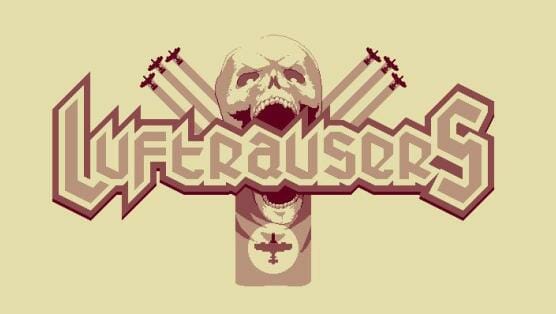Luftrausers (Multi-Platform)

“Luftrausers” is most likely a nonsense word, evocative of the jackbooted Air Forces of World War II without directly evoking them or their baggage. Luft seems obvious enough, but raus is unclear. A cursory Google leads to a Dutch-language wikitionary page which suggests that raus is a Nyonorsk noun, meaning “rage.” “Airbeserker” makes for a roughhewn calque, dubious etymological integrity notwithstanding.
Within the dyspeptic, Strangelovian alt-history world of Luftrausers, however, raus is a verb: to glide, swoop, and pirouette with balletic grace, to cleave through enemy bombers and aircraft carriers, to play Vlambeer’s new aerial combat game. “PRESS UP TO RAUS!” exhorts the tutorial.
Vlambeer has made a name for itself through an uncanny ability make games feel good. The fighter jets in Luftrausers have weight and tension. Maybe it’s all physics engines and audio-visual feedback, but that knowledge doesn’t make gloriously swandiving through a hail of bullets less satisfying.
Controlling a rauser is straightforward: pressing “up” engages the thrusters while “x” fires whichever of the half-dozen guns (think lasers and homing missiles) at your disposal you’ve chosen. Different engines and fuselage types round out Luftrausers’ customization options, each with their own deficiencies and strategies. The Gungine (gun engine) fires bullets from some aft torpedo bay while an armored body trades speed for protection. My personal favorite is the Nuke: a posthumous middle finger to my enemies that detonates during my inevitable death.
The trick is that rausers are almost invariably fast: You can pierce through the fray, cut the engines, flip the nose around, and let your momentum carry you as you fire backwards into the crowd before kicking the engines back on and zooming off to resume the fight in any of the 360 directions. The Penguin handles differently than the Widowmaker, but Luftrausers is all about using control and timing to find gaps in enemies’ bullet-hell eruptions, fire back and then flit away like a trapeze artist.
Careening through the flak-lousy sky is dangerous, though. In Luftrausers, your ship automatically and continuously heals itself as long as you’re not firing. This seems like an obvious advantage, but a timer-based combo system encourages us to seek danger instead of avoid it, and the sheer number of enemies makes not firing a dismal prospect.
Luftrausers is acrobatic, a celebration of movement and momentum, and smart players can use that to their advantage. I like herding lots of small enemies into a group and killing them all in quick succession (a trick most people probably gleaned from twin-stick shooters like Geometry Wars), like some kind of mechanized Pied Piper. Equally devious is pulling out of a freefall just so, forcing your enemies to crash to their watery graves.
Every game of Luftrausers is ostensibly similar — one plane fighting the same types of enemies across the same endlessly horizontal expanse of sea and sky — but the variation is remarkable. One of Luftrausers’ great accomplishments is the way straightforward mechanics and mix-and-match planes can bring forth these different strategies, the way such a simple set of exploding airplanes can be expressive and personalized.
Each build is named and comes with its own unique soundtrack, too. “Smalls,” for example, is a plasma cannon on an armored chassis with a Superboost engine, complete with syncopated melody on top of a fuzzy chiptune bassline. Eventually, you’ll unlock new color palettes, trading harsh neons for cool pastels and tea-stained sepia for black-and-white.
One last note on controls: I was a devotee of the original Luftrauser, an in-browser Flash prototype that I played religiously for several months last year. As a result, I feel more comfortable with keyboard controls than with an analog stick. Playing with a controller feels clumsy and imprecise to me, but that’s possibly a result of ingrained muscle memory.
-

-

-

-

-

-

-

-

-

-

-

-

-

-

-

-

-

-

-

-

-

-

-

-

-

-

-

-

-

-

-

-

-

-

-

-

-

-

-

-









































